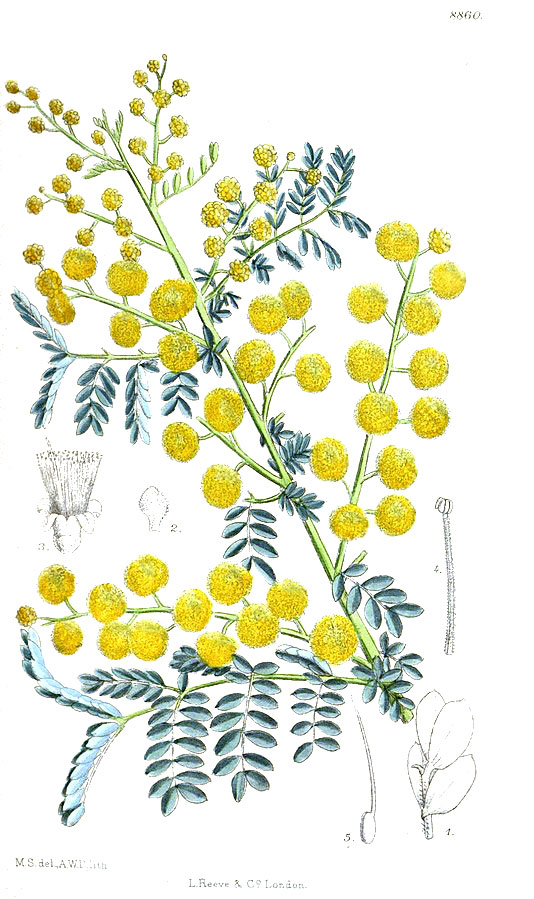Wattle

Origin: Australia
Family: Fabaceae
Scientific Name: Acacia spp.
Folk Names: Jam tree, mulga, mimosa (Europe)
Indigenous (Noongar) Names:
– Jam Wattle (Acacia acuminata): Mungart
– Manna Wattle (Acacia microbotrya): Paadyang, mindalong, badjong, galyang, koonert, menna
– Pukati (Acacia beauverdiana)
– Red-Eyed Wattle (Acacia cyclops): Wilyawa, munyuret, woolya wah
Magical
Element: Air
Day: Sunday
Planet: Sun
Zodiac: Aquarius
Associated Celebrations: Quickening
Magical Properties: Happiness, change, clarity, energy, healing, conscious mind, sleep, motherhood
Substitutions: Calendula, illyarrie, moodjar, niaouli
Magical Uses
- Use leaves in smoke cleansing to promote healing.
Medicinal
Indigenous Medicinal Uses (of various species):
- Mungart Gum eaten to treat diarrhoea and aid digestion, as were infusions of the inner Manna bark.
- Manna gum was used to soothe inflamed skin.
- Top branches of Pukati were burnt to mix the ash with Pituri (Duboisia hopwoodii or native tobacco) and chewed to relieve toothaches and other strong pains.
- Juice of crushed Wilyawa leaves were used to treat eczema.
- Flowers crushed and vapours inhaled to relax the mind to promote a good night’s sleep.
- Weak infusions of Mungart flowers were used to aid the healing of blisters and burns.
Practical
Indigenous Uses:
- Mungart Gum mixed with water to make a drink called djilyan.
- Wilyawa gum was used as chewing gum.
- Seeds and gum of several species were eaten as food.
- Seeds of several species were ground into flour to make mereny (damper).
- Green seed-pods of Wilyawa release a sticky juice that were used as insect repellent and sunscreen.
- The stems were also farmed for bardi grubs to eat.
- Leaves of Umbrella Bush (Acacia ligulata) were used to smoke people for general sickness, as well as women following childbirth.
Botanical
Acacia is the largest genus of flowering plants in Australia.
The genus was originally named for Acacia nilotica (now Vachellia nilotica), native to Africa and the Middle East, however as of 2005 the African and American acacia species have been split into separate genus' under the tribe ‘Acacieae’. Of the ~960 species that remain Acacia, all but 14 are native to Australia, and over 500 are native to WA.
Type: Evergreen shrubs/trees
Plant size: 0.2-20m
Leaves: Foliage ranges in colour from light or dark green to blue or silver-grey, and are divided into leaflets or phyllodes (flattened stems).
Flowers: Arranged in globular or cylindrical inflorescences of 3-130 flowers. The flowers have 5 very small petals, and the colour (cream through to gold) comes from the long stamens.
Fruit: As part of the legume family, the fruits form as pods, with hard, dark-brown oval-shaped seeds.
Etymology: Acacia is derived from akakia, the name given by early Greek botanist-physician Pedanius Dioscorides in the first century to the medicinal tree Acacia nilotica in his book Materia Medica. This name derives from the Ancient Greek word for its characteristic thorns, akis (“thorn”).
Wattle comes from the Old English watul, which refers to the interwoven branches and sticks which formed fences, walls and roofs, due to the plants being used for this purpose by early Australian colonisers.
In the Garden
Type: Perennial
Sow: Spring or early autumn
Light: Bright light
Water: Drought-tolerant
Soil: Well-draining
Tips:
- Water only when young, or when adult plants are showing distress in a very dry period.
- Fertilising generally unnecessary.
- Mulching recommended to conserve moisture and keep the roots cool.
- Regularly tip prune young plants to encourage more compact bushes and prune regularly after flowering (unless harvesting seeds).
- Plants have a lifespan of 7-15 years.
